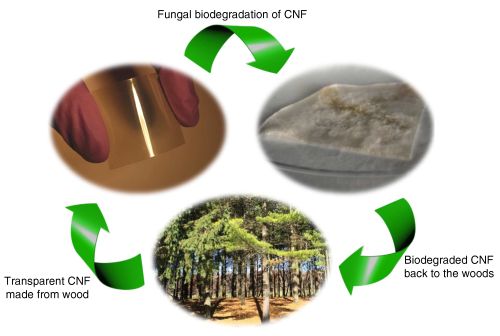|
From iPad to iPaper
Investigation of paper-based electronics continues to advance, showing exciting signs of progress.
TSUKUBA, Japan, Sep 04, 2017 - (ACN Newswire) - Imagine folding up a paper-thin computer tablet like a newspaper. It sounds like something out of a science fiction movie, but such flexible electronics are moving closer to reality, according to a review in the journal Science and Technology of Advanced Materials.
 | | Figure 1: Portable paper solar cells based on foldable, lightweight, transparent, conductive cellulose nanofiber paper. (Credit: CC-BY Macmillan Publishers Ltd) |
 | | Figure 2: Cellulose, the building block of paper taken from plants, is an exciting alternative to the plastic, glass and silicon that currently make up most electronic devices. A key benefit is that it easily biodegrades in nature. (Credit: CC-BY Macmillan Publishers Ltd) |
 | | Figure 3: An array of heterojunction bipolar transistors on a cellulose nanofiber substrate put on a tree leaf. The right image shows the red-boxed area from the left image. (Credit: CC-BY Macmillan Publishers Ltd) |
Paper that is transparent and conducts electricity could have widespread applications, including foldable computers, transparent touch screens, and even digital camouflage clothing.
"With widespread and intensive efforts, low-cost and light-weight 'green' electronics fabricated on transparent nano paper substrate will provide new technologies impacting our daily life," state the review paper authors from Nanyang Technological University in Singapore.
Cellulose, the building block of paper taken from plants, is an exciting alternative to the plastic, glass and silicon that currently make up most electronic devices, including computers and mobile phones. Cellulose is renewable, biodegradable, strong, and lightweight. For the past 30 years, scientists have considered ways to combine these properties with electronics. Significant progress has been made in the past decade to manipulate the smallest plant fibers, called "nanocellulose", for use in electronics.
For example, researchers at Nanyang Technological University have made "nanopaper" out of nanocellulose and silver nanowires. It still conducted electricity after being folded in half 500 times. Some nanopapers have reached 90% transparency, while others are in the 80% range, similar to plastic. But, better than plastic, nanopapers degrade quickly. After metal electrodes are removed, nanopaper can be buried in soil and will fully degrade within a month. Researchers are still working on how to treat nanopapers that contain non-biodegradable materials, such as epoxy, to maintain their recyclability.
Many challenges remain before nanocellulose electronics become widespread. Currently, it is more expensive to produce pure nanopaper than glass or plastic. Cheaper preparation and fabrication methods are needed. Ideally, a common high-speed printing process used in electronic manufacturing called "roll to roll" can be adapted for nanocellulose. Also, the hydrophilic properties of cellulose make the items easy to degrade; this is desirable when it is time to dispose of them, but not during their operational life. The authors are optimistic that if these issues can be addressed, a wide range of electronics could soon be built from plants.
Article information:
Shaohui Li and Pooi See Lee
"Development and applications of transparent conductive nanocellulose paper"
Science and Technology of Advanced Materials, 2017; 18:1, 620-633.
http://dx.doi.org/10.1080/14686996.2017.1364976
For further information please contact:
Pooi See Lee,
School of Materials Science and Engineering, Nanyang Technological University, Singapore
pslee@ntu.edu.sg
Journal information
Science and Technology of Advanced Materials (STAM), http://www.tandfonline.com/stam is an international open access journal in materials science. The journal covers a broad spectrum of topics, including synthesis, processing, theoretical analysis and experimental characterization of materials. Emphasis is placed on the interdisciplinary nature of materials science and on issues at the forefront of the field, such as energy and environmental issues, as well as medical and bioengineering applications.
For more information about STAM please contact
Mikiko Tanifuji
Publishing Director
Science and Technology of Advanced Materials
Tanifuji.Mikiko@nims.go.jp
Press release distributed by ResearchSEA for Science and Technology of Advanced Materials.
Source: Science and Technology of Advanced Materials
Sectors: Electronics, Science & Nanotech, Science & Research
Copyright ©2024 ACN Newswire. All rights reserved. A division of Asia Corporate News Network. |
Latest Release

First-ever Mazda CX-80 Crossover SUV Unveiled in Europe
Apr 19, 2024 13:50 JST
| 
Fujitsu develops technology to convert corporate digital identity credentials, enabling participation of non-European companies in European data spaces
Apr 19, 2024 10:17 JST
| 
Mitsubishi Heavy Industries and NGK to Jointly Develop Hydrogen Purification System from Ammonia Cracking Gas
Apr 18, 2024 17:01 JST
| 
Toyota Launches All-New Land Cruiser "250" Series in Japan
Apr 18, 2024 13:39 JST
| 
Fujitsu and Oracle collaborate to deliver sovereign cloud and AI capabilities in Japan
Apr 18, 2024 11:14 JST
| 
Eisai: Research on Treatments for Alzheimer's Disease Based on Its Pathological Mechanisms Recieves Award for Science and Technology (Research Category)
Apr 18, 2024 10:53 JST
| 
All-New Triton Confirmed as First Double-Cab Pickup Truck to Achieve 2024 Five-Star ANCAP Safety Rating
Apr 18, 2024 09:22 JST
| 
Eisai's Antiepileptic Drug Fycompa Injection Formulation Launched In Japan
Apr 17, 2024 16:17 JST
| 
Honda Unveils Next-generation EV Series for China
Apr 17, 2024 12:15 JST
| 
Lexus presents Time at the 2024 Milan Design Week
Apr 16, 2024 18:49 JST
| 
Mitsubishi Corporation Announces Participation in a DAC Project in Louisiana, USA
Apr 16, 2024 14:36 JST
| 
New circuit challenge for TOYOTA GAZOO Racing
Apr 15, 2024 17:21 JST
| 
TOYOTA GAZOO Racing back on asphalt for Croatian challenge
Apr 12, 2024 19:36 JST
| 
Heidelberg Materials North America Announces Latest Milestone in Edmonton CCUS Project
Apr 12, 2024 14:39 JST
| 
MHIAEL Completes Expansion of the its Nagasaki Plant for Manufacture of Aero Engine Combustors
Apr 11, 2024 18:08 JST
| 
Mitsubishi Shipbuilding Acquires Approval in Principle (AiP) from Classification Society ClassNK for Ammonia Fuel Supply System (AFSS)
Apr 11, 2024 17:50 JST
| 
DOCOMO, NTT, NEC and Fujitsu Develop Top-level Sub-terahertz 6G Device Capable of Ultra-high-speed 100 Gbps Transmission
Apr 11, 2024 15:10 JST
| 
Mitsubishi Corporation Announces Completion of Capital Raise by Nexamp
Apr 11, 2024 13:07 JST
| 
Mitsubishi Shipbuilding Receives Order for Ammonia Fuel Supply System for Ammonia-Powered Marine Engine
Apr 10, 2024 16:55 JST
| 
Transgene and NEC Present First Clinical Benefits of Neoantigen Cancer Vaccine, TG4050, in Head & Neck Cancer at AACR 2024
Apr 10, 2024 13:36 JST
|
More Latest Release >>
|